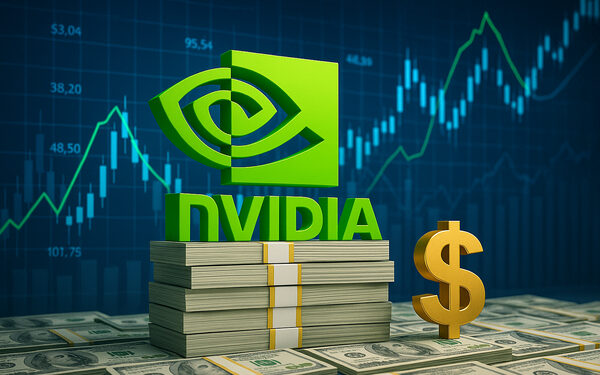Nvidia $5 Trillion Milestone Powers Market Focus Ahead of Fed and OPEC Decisions

Nvidia’s $5 trillion market cap sets the tone for global markets as traders head into a packed session with the Federal Reserve, OPEC and fresh U.S.-China trade signals all on the radar. Nvidia (NASDAQ:NVDA) broke through to $5 trillion after hitting $4 trillion three months ago, pushing AI investment narratives and pressuring peers. Short term, equity flows and volatility will track tech valuations and central bank commentary. Long term, the speed of AI capital spending and trade deals could reshape supply chains and commodity demand across the United States, Europe, and Asia. Historical jumps in valuations have sparked rotations before, so attention to policy and energy moves matters now.
Equities and AI capital spending: concentration and caution
Investor focus this week zeroed in on the winner-takes-most dynamic in AI hardware and software. Nvidia (NASDAQ:NVDA) became the first company to top a $5 trillion market capitalization, having crossed $4 trillion only three months earlier. That rapid rise has lifted sector peers and drawn scrutiny on whether spending plans can justify the valuations.
Microsoft (NASDAQ:MSFT) and Meta (NASDAQ:META) saw share price declines on concerns about an AI capex binge. Markets reacted quickly to those signs of profit-booking and re-evaluation of margins. In the near term, the market may trade this narrative around concentration in a handful of large tech names. Over the longer term, the trajectory of AI investment will determine whether this concentration widens or whether broader sectors capture productivity gains.
U.S. equity futures were higher before the bell on Friday, suggesting traders expected the headline developments to be absorbed without broad risk-off. However, the pullback in some major tech names highlights that gains concentrated in a few firms can leave indices vulnerable to profit-taking and to changes in growth assumptions.
Federal Reserve tone, rate moves and the dollar
The Federal Reserve cut interest rates by 25 basis points this week, a widely anticipated move. Fed Chair Jerome Powell also signalled that a December cut is far from certain. That hawkish nuance supported the dollar and influenced risk assets.
The dollar is on pace for roughly a 2 percent gain this month. That rise has short-term implications for multinational earnings and capital flows, particularly in emerging markets where currency moves can sharply alter local asset valuations. In addition, a firmer dollar complicates commodity pricing measured in dollars and can weigh on non-dollar demand.
Policymakers framed the decision around labor supply dynamics and the limited effectiveness of rate cuts to address those structural issues. For markets, this means the central bank remains data dependent and that headline rate moves do not fully capture the Fed’s approach to balance sheet operations and communication. Traders will watch commentary closely for any hints on balance sheet management going forward.
U.S.-China deal and the trade backdrop
News that U.S. President Donald Trump and Chinese President Xi Jinping reached an agreement altered sentiment this week. The deal reportedly includes reduced U.S. tariffs on Chinese goods and a delay to China’s rare earths curbs. Market reaction reflected relief that some trade pressures may ease.
While the deal is timely for trade flows and manufacturing planning, historical experience suggests caution. Previous phases of warming and cooling in U.S.-China relations have produced stop-start outcomes for supply chains and investment plans. In the short term, any tariff reductions could support cross-border trade and reduce near-term input costs for manufacturers in the United States and Europe.
Longer term, the arrangement may not remove strategic competition for critical technologies. Companies and policymakers will still weigh diversification of supply chains and onshoring decisions, particularly in tech and strategic minerals. Markets will screen follow-through actions and implementation details to judge the durability of the improvement in trade relations.
Energy markets, OPEC and the impact of sanctions
OPEC is set to meet this Sunday and is expected to announce another output increase. That prospect comes as Saudi Arabia faces competing pressures. U.S. oil sanctions on Russia add a geopolitical dimension that forces Riyadh to weigh economic and diplomatic priorities.
The interaction between Western sanctions and OPEC policy creates a complex environment for oil prices. In the near term, an increase in OPEC output could temper volatility and ease immediate supply concerns. However, the strategic calculation driven by sanctions and geopolitics means that member state decisions will reflect more than just short-term market balance.
There is also continuing debate over how effective sanctions have been for Russia. Analysts argue that success depends on the metric used. Markets will be sensitive to further sanctions developments and to OPEC communications that clarify production plans.
Commodities and the energy transition: copper highs and Chinese policy moves
Copper made headlines this week when the London Metal Exchange price hit a nominal record of $11,200 per metric ton. That milestone signals persistent demand pressure in metals markets, which ties into the broader narrative of electrification and infrastructure investment.
At the same time, reports suggest China’s electric vehicle output and exports may face reversal after a significant policy pivot. If China eases support, that could alter demand trajectories for key metals and affect global supply chains centered in Asia. India and Indonesia remain important consumers of coal and energy resources, with research indicating both could hit peak power sector emissions by 2030, which has implications for fuel mixes and metal demand.
In the short term, commodities will respond to immediate demand cues and geopolitical developments. Over the long term, policy shifts in major economies will shape the pace of energy transition and the structure of commodity demand. Investors and companies will watch both macro policy and specific industrial signals to assess where price pressure may persist.
Overall, markets enter the coming session with a mix of headline drivers. A landmark valuation milestone in tech has raised questions about concentration and durability. Central bank signals keep the dollar elevated while complicating liquidity expectations. Trade progress between the United States and China offers relief but carries historical caveats. Energy policy and sanctions continue to shape supply expectations and commodity prices. Traders and observers will parse data and official comments for clarity, recognizing that each of these themes interacts with the others in shaping near-term price action and longer term strategic decisions.





